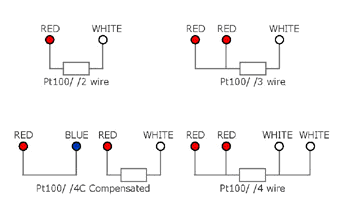Platinum resistance Pt100 sensors
The resistance to the flow of electricity in metallic materials varies with temperature. This can be used to good effect in platinum resistance detectors. Platinum is particularly stable both electrically and mechanically and is also stable with respect to time, producing a relatively linear change in resistance versus temperature.
Because the output resistance change to temperature is relatively small, it follows that lead lengths and resistances are therefore important features. In general when lead lengths are short, or can be considered as an acceptable additive content, two wire configuration is sufficient.
Three wire is the most commonly used and unless otherwise specified is supplied as standard, the third wire is the compensator for lead length and providing that all three wire have equal resistance, compensates for any ZERO or SPAN errors. (Not true for all bridges).
Four wire provides for high precision and is recommended for use with Zener Barriers.
Connection configuration

Platinum resistors are most commonly 100 ohms at 0 °C and 138.51 ohms at 100 °C. They are available in different grades according to the accuracy required and can be supplied as duplex sensors, two independent sensors on a single former.
|
